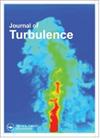一种改进的基于互K近邻的相干结构识别方法
IF 1.5
4区 工程技术
Q3 MECHANICS
引用次数: 2
摘要
提出了一种基于互k近邻(MKNN)的聚类算法,用于识别复杂流体流动中的相干结构,从而分析质量混合和输运过程。首先,利用轨迹相似度和空间接近度来描述和测量粒子间的相干性。这两个识别标准是帧不变的,因为它们是从粒子的相对距离推导出来的。然后,进一步引入相互k近邻的概念,具有相同簇标的粒子经过簇的初始化和合并过程后被识别为相干结构,而非相干区域由不相干粒子组成,它们不能与其他粒子形成相互k近邻关系。最后,将基于mknn的聚类算法应用于三个实例,实现了相干结构的识别与跟踪。识别结果表明,基于mknn的聚类算法对参数K具有较强的鲁棒性,较高的聚类数量阈值λ有助于识别流中较细的结构。空间接近度在涡流识别中表现较好,轨迹相似度在细长结构(射流)识别中表现较好。重要的是,该方法详细分析了涡旋的演化过程,包括涡旋的产生、拉伸和合并过程。综上所述,基于mknn的聚类算法以粒子轨迹作为输入数据,定量分析粒子间相对距离的演变,根据轨迹相似度和空间接近度对粒子进行聚类分析。将基于mknn的聚类算法与帧不变识别准则相结合,在复杂流体流动的相干结构识别中显示出巨大的潜力。本文章由计算机程序翻译,如有差异,请以英文原文为准。
An improved method for coherent structure identification based on mutual K-nearest neighbors
ABSTRACT The clustering algorithm based on mutual K-nearest neighbors (MKNN) is presented to identify coherent structures in complicated fluid flows, in order to analyze the mass mixing and transport. First, both trajectory similarity and spatial proximity are used to describe and measure the coherence between particles. These two identification criteria are frame-invariant since they are derived from the relative distances of particles. Then, the concept of mutual K-nearest neighbors is introduced further, and particles with the same cluster label are identified as coherent structures after the initialization and merging process of clusters, while incoherent regions consist of incoherent particles, which cannot form a mutual K-nearest neighbors relationship with other particles. Finally, the MKNN-based clustering algorithm is applied to three examples, realizing the identification and tracking of coherent structures. The identification results show that the MKNN-based clustering algorithm is robust to parameter K, and a higher threshold λ of cluster quantity will be helpful to identify the finer structures in flows. Moreover, spatial proximity performs better in vortex identification, and trajectory similarity is more suitable for elongated structures (jets) identification. Importantly, the method presented analyzes the evolutions of vortices in detail, including the generation, stretching, and merging processes. In summary, the MKNN-based clustering algorithm takes particle trajectories as input data, analyzes the evolution of relative distances between particles quantitatively, and carries out clustering analysis on particles according to trajectory similarity and spatial proximity. The combination of the MKNN-based clustering algorithm and frame-invariant identification criteria shows great potential in coherent structure identification of complicated fluid flows.
求助全文
通过发布文献求助,成功后即可免费获取论文全文。
去求助
来源期刊

Journal of Turbulence
物理-力学
CiteScore
3.90
自引率
5.30%
发文量
23
审稿时长
6-12 weeks
期刊介绍:
Turbulence is a physical phenomenon occurring in most fluid flows, and is a major research topic at the cutting edge of science and technology. Journal of Turbulence ( JoT) is a digital forum for disseminating new theoretical, numerical and experimental knowledge aimed at understanding, predicting and controlling fluid turbulence.
JoT provides a common venue for communicating advances of fundamental and applied character across the many disciplines in which turbulence plays a vital role. Examples include turbulence arising in engineering fluid dynamics (aerodynamics and hydrodynamics, particulate and multi-phase flows, acoustics, hydraulics, combustion, aeroelasticity, transitional flows, turbo-machinery, heat transfer), geophysical fluid dynamics (environmental flows, oceanography, meteorology), in physics (magnetohydrodynamics and fusion, astrophysics, cryogenic and quantum fluids), and mathematics (turbulence from PDE’s, model systems). The multimedia capabilities offered by this electronic journal (including free colour images and video movies), provide a unique opportunity for disseminating turbulence research in visually impressive ways.
 求助内容:
求助内容: 应助结果提醒方式:
应助结果提醒方式:


